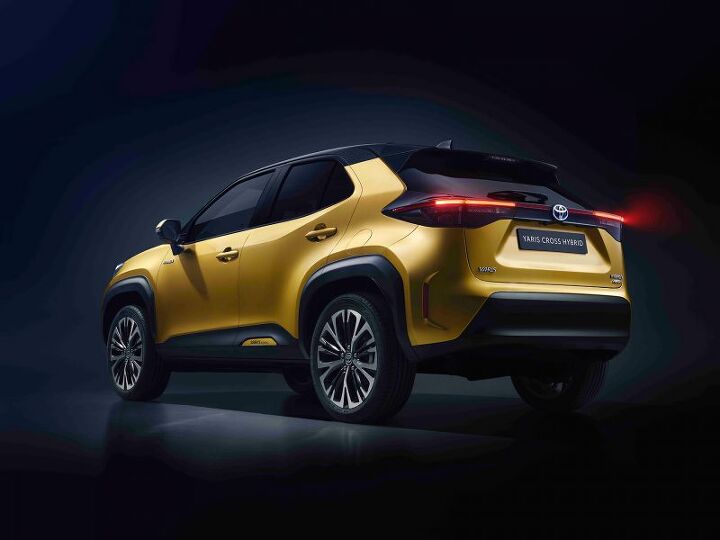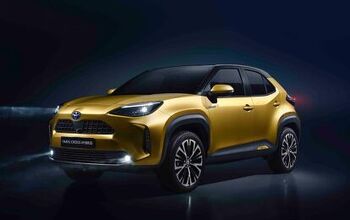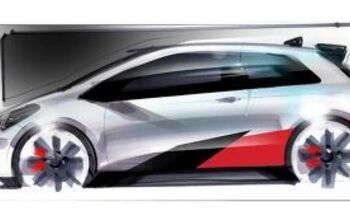Toyota Yaris Bulks Up, Becomes Yaris Cross

You won’t like it when it’s angry. Actually, you might, as the Toyota Yaris Cross small crossover seems to have not a mean bone in its body.
Boasting just three cylinders underhood whether in gas-only or hybrid guise, the Yaris Cross is what happens when enthusiasm for subcompact hatchbacks starts to wane, but the automaker doesn’t want to spoil what it already has going for it in that segment.
Riding atop the smallest TNGA platform, this Yaris undercuts the already subcompact C-HR in size by a significant degree, providing a new, cheaper stepping stone to Toyota’s broad range of utility vehicles. The model goes on sale in Japan later this year, with European customers getting a crack at in in mid-2021.
It follows on the heels of the next-generation Yaris revealed overseas late last year, but don’t hold your breath if you’re living in North America. The automaker didn’t mention additional markets. Indeed, Toyota’s Yaris strategy is very different here, with our Yaris not being a Yaris at all, but a facelifted Mazda 2.
The previous-generation, non-Mazda Yaris soldiered on until last year, with sales eventually shrinking to near zero. That said, there’s an argument to be made that, while the Yaris hatch fell out of favor among U.S. customers, a slightly upsized crossover-ish version might go over well. Size and interior volume could prove an issue, though. Remember that this is a smaller vehicle that the C-HR.
Instead, Americans might get an opportunity to get into a larger Corolla Cross in the near future. That model exists in trademark filings, and seems a better fit for the market.
So, Japanese and European buyers will get this. Powered by a 1.5-liter inline-three (with a six-speed manual or continuously variable automatic) or a hybrid drivetrain combining an Atkinson-cycle three-banger and an electric motor, the otherwise front-drive Yaris Cross offers available E-Four electric all-wheel drive. In that hybrid-only variant, the rear axle remains independent from the engine, powered solely by a rear electric motor.
[Images: Toyota]

More by Steph Willems
Latest Car Reviews
Read moreLatest Product Reviews
Read moreRecent Comments
- Theflyersfan I know their quality score hovers in the Tata range, but of all of the Land Rovers out there, this is the one I'd buy in a nanosecond, if I was in the market for an $80,000 SUV. The looks grew on me when I saw them in person, and maybe it's like the Bronco where the image it presents is of the "you're on safari banging around the bush" look. Granted, 99% of these will never go on anything tougher than a gravel parking lot, but if you wanted to beat one up, it'll take it. Until the first warning light.
- Theflyersfan $125,000 for a special M4. Convinced this car exists solely for press fleets. Bound to be one of those cars that gets every YouTube reviewer, remaining car magazine writer, and car site frothing about it for 2-3 weeks, and then it fades into nothingness. But hopefully they make that color widespread, except on the 7-series. The 7-series doesn't deserve nice things until it looks better.
- Master Baiter I thought we wanted high oil prices to reduce consumption, to save the planet from climate change. Make up your minds, Democrats.
- Teddyc73 Oh look dull grey with black wheels. How original.
- Teddyc73 "Matte paint looks good on this car." No it doesn't. It doesn't look good on any car. From the Nissan Versa I rented all the up to this monstrosity. This paint trend needs to die before out roads are awash with grey vehicles with black wheels. Why are people such lemmings lacking in individuality? Come on people, embrace color.



































Comments
Join the conversation
God that is hideous looking. I feel slightly ill.
Can we expect a GR version soon?